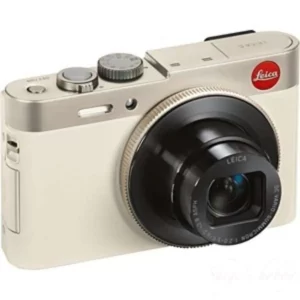Last updated on 2025-10-26
A review and Photo example of the LEICA compact digital camera LEICA C typ112.
- Please see the disclaimer regarding advertising here.
- Italicized links in the text are advertisement links that take you to other sites.
Table of contents
Gallery
Review

1.Overview
The Leica C typ112 is a compact digital camera released in 2013.
- The sensor size is 1/1.7 inches
- The sensor pixel count is 12.1 million pixels
- It has a wide shooting range, covering focal lengths from 28mm to 200mm.
- Shooting distances are 3cm to ∞ on the wide-angle side and 0.8m to ∞ on the telephoto side in macro mode
- Equipped with a 200,000-dot EVF
- The rear has a 920,000-dot 3-inch LCD
This camera is an OEM of Panasonic, and the original camera was the LUMIX DMC-LF1
2.Usability
The Leica C typ112 is the first release in five years since the C-LUX3, the predecessor of the C series of compact digital cameras. As of 2025, it is the latest Leica compact digital camera equipped with a small sensor of 1 inch or less.
It is a compact digital camera that follows the trend of compact digital cameras in the 2010s, which includes a telephoto focal length in a thin body.
The telephoto end of 200mm for handheld shooting only produced soft images with low resolution, even when the ISO sensitivity was increased or image stabilization was relied upon, so I ended up only using the telephoto end at around 100mm.
You may be able to get decent images with the maximum telephoto setting if you attach it to a tripod. However, what you want from this camera is snapshot photography that takes advantage of its compactness, and if you cannot get decent images handheld, that focal length is not worth using.
If the Leica C’s 28mm to 100mm focal length is considered to be the practical focal length, then the previous C-LUX3’s 24mm focal length on the wide-angle side is more effective for general landscape photography.
The fact that a camera of this size is equipped with an EVF is also appreciated in terms of shooting stability at telephoto and differentiation from other companies.
Unfortunately, due to size and cost issues, it is equipped with a low-pixel EVF of 200,000 dots, the same as EVFs from the 2000s. Therefore, it is difficult to check the focus position and color reproduction when shooting, and it can only be used to check the shooting range and composition. It is unfortunate that the display quality is so different from the EVF because the resolution of the rear LCD is 920,000 dots, which is quite high resolution.
The sensor is 1/1.7, which is larger than the previous C-LUX. The image quality is standard for compact digital cameras in 2013, and is decent under sunny conditions. However, when the ISO sensitivity is increased in a dark place, noise specific to small-sized sensors becomes apparent.
The lens also has noticeable distortion at the wide-angle end, especially when recording RAW in Panasonic RWL format. This is a camera that is mainly used for shooting in JPEG format with the assumption that correction will be performed.
3.Summary
In conclusion , to sum up the Leica C typ112, it is a compact digital camera with an enhanced telephoto side.
Although there are some questionable practical aspects, such as the performance of the EVF and the effectiveness of the image stabilization, it is a useful camera to keep in your pocket for taking notes.
Leica has been quiet on small sensor compact digital cameras, but it will be selling the D-LUX8 with a Micro Four Thirds sensor in 2024, and we can expect the release of more compact digital cameras with integrated lenses in the future.
Specification
The difference between the LEICA C and the DMC-LF1 is the color variations and the exterior design. The Leica C is clad in a bright gold and a dark red. The difference in the exterior design is the shape of the camera’s top plate. The Leica C has an L-shaped step in the center of the camera and the raised EVF is coordinated with the entire body. It is a highly refined design that creates a Leica-like feel with minimal changes from the original camera design.
The original Panasonic LF1 has a flat top line and the operation dial, buttons and EVF are raised from the top plate, which lacks cohesion as a whole. It is also only available in a dark black color.
Still, compared to past Panasonic camera designs, the LF1 has no unnecessary bumps on the front of the body, making it a clean and stylish camera.
The Leica version and the Panasonic version have the same performance specifications, so it is difficult to tell the difference between the two from the shooting results.
Panasonic, with which the company has an OEM partnership, continues to release high-magnification zoom cameras with small sensors, such as the LUMIX TZ95D in 2022 and the LUMIX TZ99 in 2025. There appear to be no plans to release a Leica-branded camera based on this.
| Items | LEICA C | DMC-LF1 |
| Effective pixels(Megapixels) | 12.1-Megapixels | 12.1-Megapixels |
| Lens construction | LEICA DC VARIO-SUMMICRON f=6~42.8mm 35mm format conversion: 28-200mm | LEICA DC VARIO-SUMMICRON f=6~42.8mm 35mm format conversion: 28-200mm |
| Sensor size | 1/1.7 type MOS sensor | 1/1.7 type MOS sensor |
| View finder | Color LCD viewfinder 0.2 type, equivalent to 200,000 dots | Color LCD viewfinder 0.2 type, equivalent to 200,000 dots |
| Rear LCD | 3.0型 | 3.0型 |
| Min distance | SDXC card: No maximum capacity listed | SDXC card: No maximum capacity listed |
| Build in memory | Approximately 87MB Can take about 20 photos | Approximately 87MB Can take about 20 photos |
| Battery | BP-DC14 | DMW-BCN10 |
| Size(mm) W x H x D | 102.5 × 62.1 × 27.9(mm) | 102.5 × 62.1 × 27.9(mm) |
| Weight (g) (with battery) | 173 | 173 |
| Release date | 2013.10.19 | 2013.6.20 |
| Price | Open Direct store price: 86,100 yen | Open Initial sales price was just under 40,000 yen |
Options
- Twist (camera case) for Leica C(18784)
- Snap (front cap) for Leica C(18786)
- clutch bag(18788)
Reference links
Affiliate links
- Leica Lens・Ads by Amazon
- Leica Books・Ads by Amazon
- Leica Digital Camera Leica C Typ 112・Ads by Amazon
- Panasonic Digital Camera Lumix LF1・Ads by Amazon
- LEICA C-LUX3・Ads by Amazon
- BP-DC14・Ads by Amazon
- DMW-BCN10・Ads by Rakuten

Amazon Prime Sale
Update history
- 2025.7.22
- 2025.3.17
- 2024.8.21
- 2024.04.05
- 2023.07.05



Be First to Comment